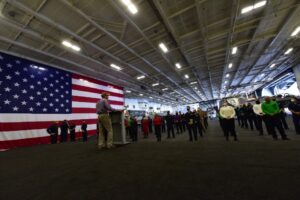Secretary of Defense Mark Esper last week told sailors unmanned vehicles will allow the Navy to increase over a planned 355 ships.
Esper spoke to sailors while visiting the USS Carl Vinson (CVN-70) in the Pacific Ocean on Sept. 17, currently conducting flight deck certifications in preparation for future operations.

He said in the future the Navy will have a more balanced force to deliver effects from sea, land, air, space, and cyberspace.
“Unmanned will enable us to grow the United States Navy well beyond 355 ships. It will add more lethality, survivability and capability,” Esper said.
The visit came during a trip to California to look into Navy and Marine Corps unmanned systems, readiness and modernization efforts.
While in California, Esper planned to visit Boeing’s [BA] facility with the Echo Voyager prototype that is the basis for the Navy’s Orca Extra Large Unmanned Underwater Vehicle as well as see the Pentagon’s Sea Hunter prototype medium unmanned surface vessel.
Previously, during a Sept. 16 speech at RAND at the start of the California trip, Esper said a new future fleet forces study recommends expanding the Navy beyond 355 ships but require billions of dollars more in Navy shipbuilding funds (Defense Daily, Sept. 16).
Esper commissioned Deputy Secretary of Defense David Norquist to conduct the study earlier this year, overriding the Navy’s previously completed but undisclosed force structure assessment and 30-year shipbuilding plan.
According to his prepared remarks for the event, Esper said this would mean returning the Navy to a shipbuilding budget percentage akin to the Reagan administration’s increase at 13 percent compared to the current 11 percent. He did not elaborate if this would involve increasing the overall Navy budget or shifting internal funds to increase shipbuilding at the expense of other budget items.
In contrast, Esper’s remarks as delivered excised any talk of specific percentages. During the speech, he said, “we must increase funding for shipbuilding and the readiness that sustains a larger force. Doing this, and finding the money within the Navy budget and elsewhere to make it real, is something both the Navy leadership and I are committed to doing.”
This may be an allusion to the Navy effort akin to the Army’s “Night Court” savings session.
In February, former Acting Secretary of the Navy Thomas Modly directed a Stern-to-Stern strategic review aimed at saving $8 billion per year to reach $40 billion in savings over five years (Defense Daily, Feb. 19).
“We must find savings within the Department to reinvest in the kind of decisive naval force that will provide for our nation’s future economic and political security. The bottom line is that we need to find at least $40 billion in real line-of-accounting savings to fund the development, construction, and sustainment of this new fleet over the next 5 years, and to set the Department up for continuing this trajectory in the 5 years that follow,” Modly wrote in a February memo directing the review.